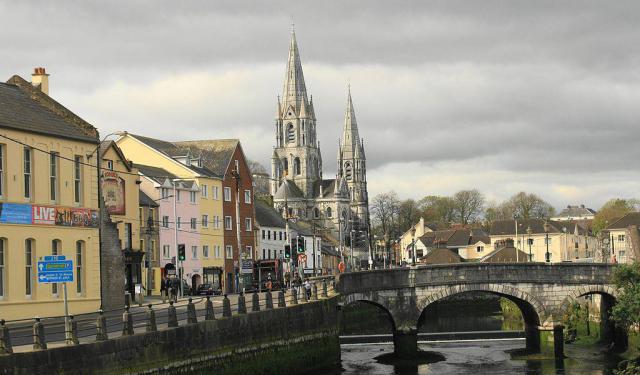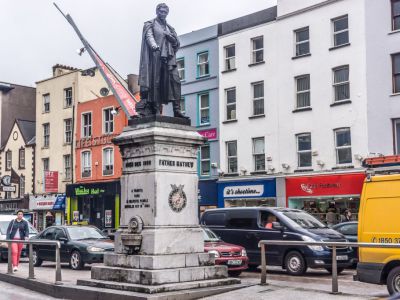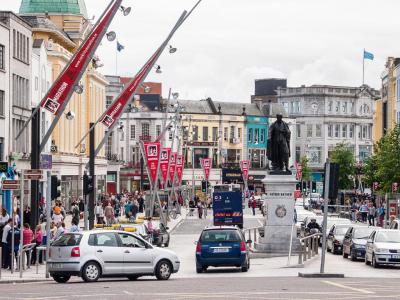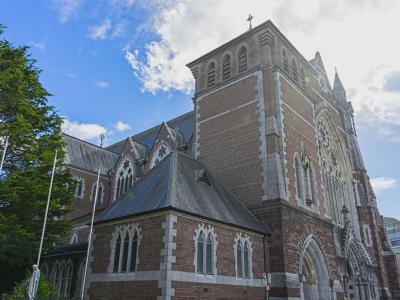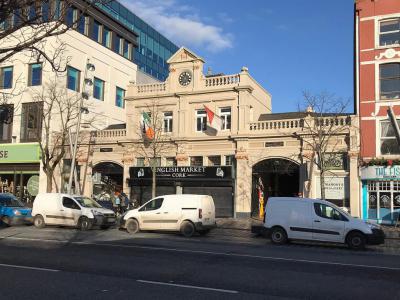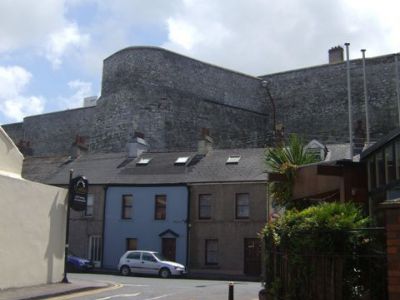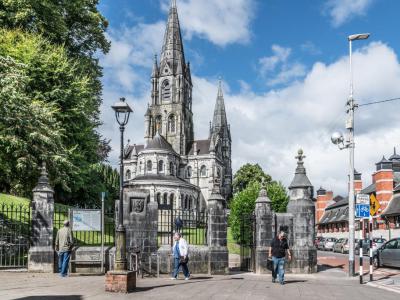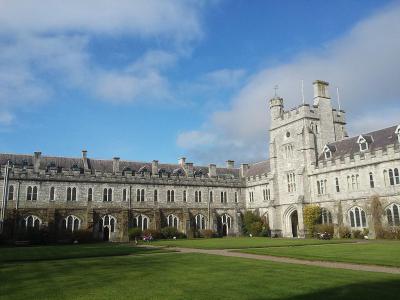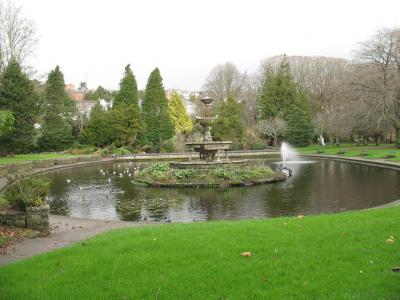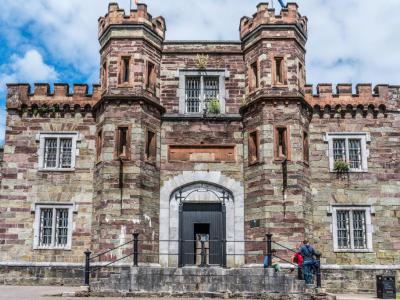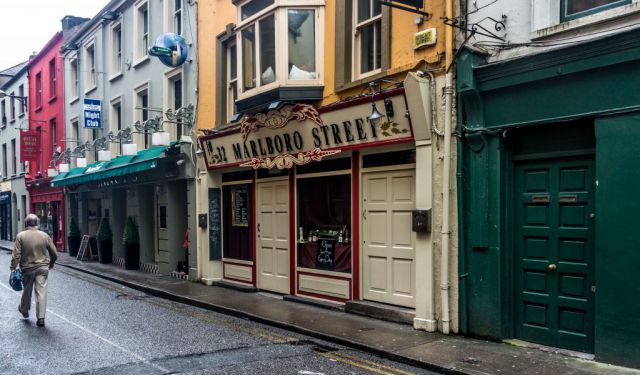Audio Guide: Cork Introduction Walking Tour (Self Guided), Cork
Cork’s story starts in the 6th century, when Saint Finn Barr decided that a patch of soggy ground was the perfect place for a monastery. The swampiness of the place was immortalized in its original Irish name Corcaigh or corcach, meaning “marsh”. It was a quiet, devout little community… until the Vikings showed up between 915 and 922. They parked their longships, set up a trading port, and plugged Cork into a Scandinavian network that stretched far beyond the Irish Sea. From then on, the town was less “remote monastery” and more “international port of call.”
By 1185, the Anglo-Normans had arrived with a city charter in hand, giving Cork an official seat at the medieval table. Surrounded by a Gaelic hinterland, it became a walled Old English enclave-part marketplace, part fortress. Then came 1491, when Cork backed the wrong royal claimant in the Wars of the Roses, earning a reputation for mischief that stuck. The nickname “the rebel city” wasn’t just poetic; it was practically a badge of honour.
Fast-forward a few centuries, and Cork was thriving as an Atlantic port in the 18th and 19th centuries, shipping out butter, beef, and other goods. The political spirit was as strong as the trade winds, and during the Irish War of Independence, the city’s nationalist heart was on full display. In December 1920, the “Burning of Cork” saw British forces torch much of the centre, leaving behind smouldering ruins but not a broken spirit.
One survivor of time-though not from the fire-is St. Fin Barre’s Cathedral. Completed in 1879 on the exact spot where the city began, its Gothic Revival towers, elaborate carvings, and kaleidoscopic stained glass make it as much a history lesson as a place of worship.
Cork’s commercial lifeblood runs through the English Market, open since 1788. Beneath its iron-and-glass canopy, stalls offer fresh fish, spiced meats, local cheeses, and the occasional culinary curiosity that might raise an eyebrow. It is a social meeting ground combined with shopping frenzy.
Today, Cork wears its history in plain view-Viking waterways, medieval street grids, Georgian façades, and lively markets all crammed into a compact, walkable core. For a city born in a marsh, it’s proved remarkably good at staying afloat. Don't you worry, follow this guide and you won't get swamped by the variety.
By 1185, the Anglo-Normans had arrived with a city charter in hand, giving Cork an official seat at the medieval table. Surrounded by a Gaelic hinterland, it became a walled Old English enclave-part marketplace, part fortress. Then came 1491, when Cork backed the wrong royal claimant in the Wars of the Roses, earning a reputation for mischief that stuck. The nickname “the rebel city” wasn’t just poetic; it was practically a badge of honour.
Fast-forward a few centuries, and Cork was thriving as an Atlantic port in the 18th and 19th centuries, shipping out butter, beef, and other goods. The political spirit was as strong as the trade winds, and during the Irish War of Independence, the city’s nationalist heart was on full display. In December 1920, the “Burning of Cork” saw British forces torch much of the centre, leaving behind smouldering ruins but not a broken spirit.
One survivor of time-though not from the fire-is St. Fin Barre’s Cathedral. Completed in 1879 on the exact spot where the city began, its Gothic Revival towers, elaborate carvings, and kaleidoscopic stained glass make it as much a history lesson as a place of worship.
Cork’s commercial lifeblood runs through the English Market, open since 1788. Beneath its iron-and-glass canopy, stalls offer fresh fish, spiced meats, local cheeses, and the occasional culinary curiosity that might raise an eyebrow. It is a social meeting ground combined with shopping frenzy.
Today, Cork wears its history in plain view-Viking waterways, medieval street grids, Georgian façades, and lively markets all crammed into a compact, walkable core. For a city born in a marsh, it’s proved remarkably good at staying afloat. Don't you worry, follow this guide and you won't get swamped by the variety.
How it works: Download the app "GPSmyCity: Walks in 1K+ Cities" from Apple App Store or Google Play Store to your mobile phone or tablet. The app turns your mobile device into a personal tour guide and its built-in GPS navigation functions guide you from one tour stop to next. The app works offline, so no data plan is needed when traveling abroad.
Cork Introduction Walking Tour Map
Guide Name: Cork Introduction Walking Tour
Guide Location: Ireland » Cork (See other walking tours in Cork)
Guide Type: Self-guided Walking Tour (Sightseeing)
# of Attractions: 10
Tour Duration: 2 Hour(s)
Travel Distance: 4.0 Km or 2.5 Miles
Author: DanaOffice
Sight(s) Featured in This Guide:
Guide Location: Ireland » Cork (See other walking tours in Cork)
Guide Type: Self-guided Walking Tour (Sightseeing)
# of Attractions: 10
Tour Duration: 2 Hour(s)
Travel Distance: 4.0 Km or 2.5 Miles
Author: DanaOffice
Sight(s) Featured in This Guide:
- Father Mathew Statue
- St. Patrick's Street
- St. Peter and Paul's Church
- English Market
- Oliver Plunkett Street
- Elizabeth Fort
- St. Fin Barre's Cathedral
- University College Cork
- Fitzgerald Park
- Cork City Gaol
1) Father Mathew Statue
On Cork’s busy St. Patrick’s Street, there’s a figure who’s been keeping an unblinking watch since 1864: Father Theobald Mathew, better known as the “Apostle of Temperance.” Born in 1790 and arriving in Cork in 1814, Mathew was the kind of priest who didn’t just preach-he acted. Whether tending to the sick during the cholera outbreak of 1832 or helping the destitute during the Great Famine, he built a reputation for compassion. Then came 1838, when he launched the Knights of Father Mathew, a temperance movement that convinced millions across Ireland to give up the drink-a bold crusade in a city that’s always had a healthy relationship with its pubs.
When Mathew died in 1856, Cork decided he deserved a tribute worthy of his influence. The task first went to sculptor John Hogan, but fate intervened and the job passed to John Foley. Cast in London and unveiled on October 10, 1864, the monument bears the inscription “A Tribute From a Grateful People.” It has held its ground ever since-quite literally-surviving a relocation attempt in 2000 thanks to strong public pushback.
In its early years, the statue wasn’t just a symbol-it was a landmark for Cork’s electric tram system, often treated as the city’s unofficial central point. Today, it’s still a meeting spot, surrounded by the hum of shops, cafés, and constant foot traffic, as if Father Mathew has been drafted into Cork’s daily life as an honorary host.
The statue is more than bronze on stone. It’s a reminder of a man who challenged social habits, inspired change, and became woven into the city’s identity.
When Mathew died in 1856, Cork decided he deserved a tribute worthy of his influence. The task first went to sculptor John Hogan, but fate intervened and the job passed to John Foley. Cast in London and unveiled on October 10, 1864, the monument bears the inscription “A Tribute From a Grateful People.” It has held its ground ever since-quite literally-surviving a relocation attempt in 2000 thanks to strong public pushback.
In its early years, the statue wasn’t just a symbol-it was a landmark for Cork’s electric tram system, often treated as the city’s unofficial central point. Today, it’s still a meeting spot, surrounded by the hum of shops, cafés, and constant foot traffic, as if Father Mathew has been drafted into Cork’s daily life as an honorary host.
The statue is more than bronze on stone. It’s a reminder of a man who challenged social habits, inspired change, and became woven into the city’s identity.
2) St. Patrick's Street
If you follow the curve of the River Lee into the heart of Cork, you’ll find St. Patrick’s Street-though if you want to sound local, just call it “Pana.” Born in the 18th century from reclaimed marshland, it was laid out as an elegant link between St. Patrick’s Bridge and Daunt Square. Since then, it’s become Cork’s main stage for commerce and conversation, with high-street names like Marks & Spencer and Penneys mingling with homegrown boutiques and cafés. In the middle of it all stands the 1864 Father Mathew Statue, a steadfast landmark and an easy meeting point.
This street hasn’t had a smooth ride. In December 1920, during the Irish War of Independence, the Burning of Cork reduced landmarks like the Munster Arcade and Grant’s department store to ashes. The rebuild that followed gave “Pana” its distinctive blend of Victorian façades and modern shopfronts-a patchwork that mirrors Cork’s talent for reinvention.
The 21st century brought more change, this time on purpose. In 2004, wider pavements and open plazas made strolling easier, Opera Lane appeared in 2010, and a facelift for shopfronts followed in 2016. Those upgrades helped the street bag two national titles as Ireland’s best shopping street, proof that it knows how to keep up appearances.
For visitors, it’s a stretch of city where you can hop from a record store to a souvenir shop, duck into a gallery, then grab lunch before chasing down a sale on designer shoes. Seasonal events can transform it overnight-from St. Patrick’s Day parades to pop-up performances-making it an entertainment hub. Walk it once, and you’ll understand how this curve in the road has managed to hold the city’s attention for over two centuries.
This street hasn’t had a smooth ride. In December 1920, during the Irish War of Independence, the Burning of Cork reduced landmarks like the Munster Arcade and Grant’s department store to ashes. The rebuild that followed gave “Pana” its distinctive blend of Victorian façades and modern shopfronts-a patchwork that mirrors Cork’s talent for reinvention.
The 21st century brought more change, this time on purpose. In 2004, wider pavements and open plazas made strolling easier, Opera Lane appeared in 2010, and a facelift for shopfronts followed in 2016. Those upgrades helped the street bag two national titles as Ireland’s best shopping street, proof that it knows how to keep up appearances.
For visitors, it’s a stretch of city where you can hop from a record store to a souvenir shop, duck into a gallery, then grab lunch before chasing down a sale on designer shoes. Seasonal events can transform it overnight-from St. Patrick’s Day parades to pop-up performances-making it an entertainment hub. Walk it once, and you’ll understand how this curve in the road has managed to hold the city’s attention for over two centuries.
3) St. Peter and Paul's Church
Let's say you’re strolling down Saint Patrick’s Street, scanning the storefronts, and suddenly a sweep of limestone and pointed arches interrupts the flow of shop windows. That’s St. Peter and Paul’s Church - a Gothic Revival flourish from the mid-19th century, planted on ground where Catholic churches weren’t even allowed a century earlier. Between 1859 and 1866, architect E.W. Pugin, son of Gothic revival champion Augustus Pugin, brought this vision to life for a city whose Catholic community was ready to build with confidence. The result? A structure that announces itself with pride even without the towering spire it once dreamed of - a casualty of budget and structural caution.
The exterior does its job - handsome, dignified, undeniably Gothic - but the real magic waits inside. Here, red marble pillars rise under finely carved timber ceilings, the light pouring through stained-glass windows in a way that turns the space into a living kaleidoscope. The high altar demands attention with its intricate detail, while the Russian oak pulpit seems to have absorbed every sermon ever preached from it. Biblical scenes unfold in glass and stone, each one rendered with a care that rewards slow looking.
It’s not a space you rush through. Every detail - from the arches to the altar rail - feels like it was meant to be noticed. Photographers can chase the light as it shifts through the day, history fans can tick off another E.W. Pugin work from their list, and anyone craving a moment of calm will find it here, right in the churn of the city centre.
The exterior does its job - handsome, dignified, undeniably Gothic - but the real magic waits inside. Here, red marble pillars rise under finely carved timber ceilings, the light pouring through stained-glass windows in a way that turns the space into a living kaleidoscope. The high altar demands attention with its intricate detail, while the Russian oak pulpit seems to have absorbed every sermon ever preached from it. Biblical scenes unfold in glass and stone, each one rendered with a care that rewards slow looking.
It’s not a space you rush through. Every detail - from the arches to the altar rail - feels like it was meant to be noticed. Photographers can chase the light as it shifts through the day, history fans can tick off another E.W. Pugin work from their list, and anyone craving a moment of calm will find it here, right in the churn of the city centre.
4) English Market (must see)
Step off the busy streets of Cork and into the English Market, and you’ll swap the hum of traffic for the soft shuffle of footsteps and the clink of traders’ tools. Established in 1788 as the “new markets” for meat, it has since evolved into a feast for the senses - and the appetite. The name “English Market” came later, in the 19th century, to set it apart from the Irish Market on St. Peter’s. The present building, with its admired mid-19th-century architecture, greets visitors through the elegant tripartite façade on Princes Street or the bayed entrance from the Grand Parade. Inside, a gabled bay, central archways, and stained-glass lunette windows create an atmosphere that feels both vintage and alive.
This is not just a stroll-and-stare kind of place. It’s where locals pick up their spiced beef for Sunday, where chefs hunt for the best fish in town, and where self-catering travellers can stock up on top-quality Irish produce. You’ll find fruit and vegetables from far-flung places, but the real pride lies in local specialities - blood sausage, buttered eggs, and a butcher’s counter that could stock half the city. The quality here is so consistent that many of Cork’s best restaurants take their cues (and their cuts) from these stalls.
The market’s reputation has outgrown the city, drawing praise from food lovers worldwide - including chef Rick Stein, who once called it the “best covered market in the UK and Ireland.” It’s also hosted royal visitors like Queen Elizabeth II and Prince Charles and even made appearances in The Young Offenders. The English Market delivers more than groceries: it’s a snapshot of Cork’s culinary identity, a clean and charming old-world marketplace where every counter has a story, and every merchant is willing to talk about it.
This is not just a stroll-and-stare kind of place. It’s where locals pick up their spiced beef for Sunday, where chefs hunt for the best fish in town, and where self-catering travellers can stock up on top-quality Irish produce. You’ll find fruit and vegetables from far-flung places, but the real pride lies in local specialities - blood sausage, buttered eggs, and a butcher’s counter that could stock half the city. The quality here is so consistent that many of Cork’s best restaurants take their cues (and their cuts) from these stalls.
The market’s reputation has outgrown the city, drawing praise from food lovers worldwide - including chef Rick Stein, who once called it the “best covered market in the UK and Ireland.” It’s also hosted royal visitors like Queen Elizabeth II and Prince Charles and even made appearances in The Young Offenders. The English Market delivers more than groceries: it’s a snapshot of Cork’s culinary identity, a clean and charming old-world marketplace where every counter has a story, and every merchant is willing to talk about it.
5) Oliver Plunkett Street
Oliver Plunkett Street has been in the thick of Cork’s story since the early 1700s, when it was laid out as part of the city’s push southward. Back then, it answered to the name George’s Street, in honour of King George I, and quickly became one of the city’s commercial lifelines. That all changed after the Burning of Cork in 1920 left it badly scarred; two years later, with the Irish Free State taking shape, it got its new title, this time saluting Saint Oliver Plunkett. The locals, of course, weren’t in any rush to update their vocabulary-many stubbornly stuck to “George’s Street” or even “Late George’s Street” for years, official maps and all, while the General Post Office quietly sat right on the “new” street.
A stroll here is like flipping through a scrapbook of Cork’s commercial past. Victorian façades share the stage with early 20th-century shopfronts, their decorative flourishes and original detailing giving the street a flavour you won’t find in gleaming modern malls. The pedestrian-only stretch between Parnell Place and Grand Parade turns into a broad, easy-going promenade from mid-morning to late afternoon. That slower pace-along with the chance to linger over window displays or grab an outdoor table-earned it the Great Street Award from the London Academy of Urbanism in 2016. Come festival season, the place hums with live music, street performers, and a sea of festive décor.
Today, it’s a cultural pit stop. International brands keep company with independent boutiques, artisan coffee spots, and lanes that tempt you off-course into pubs, galleries, and quirky specialty shops. Food lovers can nibble their way through everything from fresh-baked Irish breads to global street food. And with the English Market, St. Patrick’s Street, and the city’s historic backstreets just around the corner, Oliver Plunkett Street slides neatly into any walking tour of Cork’s buzzing heart.
A stroll here is like flipping through a scrapbook of Cork’s commercial past. Victorian façades share the stage with early 20th-century shopfronts, their decorative flourishes and original detailing giving the street a flavour you won’t find in gleaming modern malls. The pedestrian-only stretch between Parnell Place and Grand Parade turns into a broad, easy-going promenade from mid-morning to late afternoon. That slower pace-along with the chance to linger over window displays or grab an outdoor table-earned it the Great Street Award from the London Academy of Urbanism in 2016. Come festival season, the place hums with live music, street performers, and a sea of festive décor.
Today, it’s a cultural pit stop. International brands keep company with independent boutiques, artisan coffee spots, and lanes that tempt you off-course into pubs, galleries, and quirky specialty shops. Food lovers can nibble their way through everything from fresh-baked Irish breads to global street food. And with the English Market, St. Patrick’s Street, and the city’s historic backstreets just around the corner, Oliver Plunkett Street slides neatly into any walking tour of Cork’s buzzing heart.
6) Elizabeth Fort
Elizabeth Fort in Cork looks like a stone star dropped on the city map, though its origins were anything but peaceful. It first appeared in 1601, ordered by Sir George Carew and named for Queen Elizabeth I, right after the Battle of Kinsale on Christmas Eve put everyone on edge. Perched just outside the medieval walls, it kept watch for trouble-until 1603, when it was torn down. By the early 1620s, Carew had it rebuilt in stone, giving it the sturdy form that still stands today.
Back then, the fort sat high and outside the city. As Cork swelled, it was eventually swallowed by the streets around it. Its purpose shifted with the times-defending the city during the 1690 Siege of Cork, housing soldiers, storing convicts, and later serving as headquarters for the Royal Irish Police. By the 20th century, the National Police moved in, before history finally claimed it as a heritage site.
These days, the place is as much a stage as it is a monument. Festivals spill through its gates-Cork Midsummer Festival, St. Patrick’s celebrations, Culture Night-and the walls echo with music, chatter, and the shuffle of curious visitors. Strolling its ramparts offers a full sweep of the city, with St. Fin Barre’s Cathedral stealing the skyline.
Inside, exhibits unpack its many past lives, from cannon smoke to police boots, tracing the story of a fort that never stopped adapting. Its star-shaped design is straight out of the early modern military playbook, complete with bastions and ramparts that make it easy to imagine its defensive days.
Back then, the fort sat high and outside the city. As Cork swelled, it was eventually swallowed by the streets around it. Its purpose shifted with the times-defending the city during the 1690 Siege of Cork, housing soldiers, storing convicts, and later serving as headquarters for the Royal Irish Police. By the 20th century, the National Police moved in, before history finally claimed it as a heritage site.
These days, the place is as much a stage as it is a monument. Festivals spill through its gates-Cork Midsummer Festival, St. Patrick’s celebrations, Culture Night-and the walls echo with music, chatter, and the shuffle of curious visitors. Strolling its ramparts offers a full sweep of the city, with St. Fin Barre’s Cathedral stealing the skyline.
Inside, exhibits unpack its many past lives, from cannon smoke to police boots, tracing the story of a fort that never stopped adapting. Its star-shaped design is straight out of the early modern military playbook, complete with bastions and ramparts that make it easy to imagine its defensive days.
7) St. Fin Barre's Cathedral (must see)
Saint Finn Barre’s Cathedral practically crowns Cork, with three spires that have been keeping watch since the late 19th century. But the story goes back much further. In the 7th century, Saint Fin Barre, Cork’s patron, founded a monastery here. That first building didn’t survive the 12th-century Norman invasion, and its successors fared no better-each replaced by something grander, as if every generation was trying to outdo the last. The Gothic Revival masterpiece you see today was built between 1863 and 1879, designed by William Burges, a man who wasn’t content to just draw blueprints-he dreamed up everything from the stained glass to the furniture.
Burges was so determined to see the cathedral completed his way that he left behind two detailed “how-to” manuals-the Book of Furniture and the Book of Designs-like a Victorian IKEA guide, only with more angels and gargoyles. Those plans have kept restorations faithful to the original, even down to re-carving sculptures degraded by Cork’s damp climate. Built mainly from local limestone, with marble columns inside, the cathedral’s skyline signature is the gilded copper “Golden Angel,” gleaming from the sanctuary roof.
Step inside and it’s sensory overload-in the best way. Mosaic pavements underfoot, a marble nave soaring above, and a pulpit propped up on four sculpted legs. The brass lectern stares back at you with the faces of Moses and King David. Seventy-four stained glass windows tell biblical tales, except in the nave, where the signs of the zodiac sneak in. The 1870 William Hill & Sons pipe organ has more than 4,500 pipes, making sure any note played resonates through both stone and soul. And if you can brave a steep, dim staircase, you’ll be rewarded with a sweeping panorama of Cork, spires in the foreground, rooftops fading into the distance.
Today, St. Fin Barre’s is more than a place of worship-it’s part of Cork’s cultural bloodstream, hosting concerts, events, and standing within easy reach of Elizabeth Fort and the city’s historic lanes. For anyone with an eye for architecture, a love of history, or just an appreciation for an excellent city view, it’s a stop that delivers on every level.
Burges was so determined to see the cathedral completed his way that he left behind two detailed “how-to” manuals-the Book of Furniture and the Book of Designs-like a Victorian IKEA guide, only with more angels and gargoyles. Those plans have kept restorations faithful to the original, even down to re-carving sculptures degraded by Cork’s damp climate. Built mainly from local limestone, with marble columns inside, the cathedral’s skyline signature is the gilded copper “Golden Angel,” gleaming from the sanctuary roof.
Step inside and it’s sensory overload-in the best way. Mosaic pavements underfoot, a marble nave soaring above, and a pulpit propped up on four sculpted legs. The brass lectern stares back at you with the faces of Moses and King David. Seventy-four stained glass windows tell biblical tales, except in the nave, where the signs of the zodiac sneak in. The 1870 William Hill & Sons pipe organ has more than 4,500 pipes, making sure any note played resonates through both stone and soul. And if you can brave a steep, dim staircase, you’ll be rewarded with a sweeping panorama of Cork, spires in the foreground, rooftops fading into the distance.
Today, St. Fin Barre’s is more than a place of worship-it’s part of Cork’s cultural bloodstream, hosting concerts, events, and standing within easy reach of Elizabeth Fort and the city’s historic lanes. For anyone with an eye for architecture, a love of history, or just an appreciation for an excellent city view, it’s a stop that delivers on every level.
8) University College Cork (must see)
If Cork had an academic crown jewel, University College Cork would be it-though it began life in 1845 as Queen’s College Cork, one of three colleges founded under Queen Victoria. By 1908, it had joined the National University of Ireland and swapped the royal title for its current name. The original quadrangle, in stately Tudor Gothic style, still anchors the 42-acre campus. And while its lawns roll gently down to the River Lee, the whole place sits just a brisk ten-minute walk from Cork’s city centre.
This is also the campus that made medical history in 1898, when Ireland’s first two female doctors graduated here-decades before many universities even considered opening those door to women. The stone façades and arched windows look suitably scholarly, but the details tell their own stories. The Aula Maxima, the university’s ceremonial heart, brims with portraits and period furnishings. At the Crawford Observatory, late-19th-century telescopes-restored to working order-still point skyward, recalling a time of astronomy lectures.
In more recent history, UCC has been named Irish University of the Year five times and once claimed the European Commission’s title for top performing university. On the cultural side, the Glucksman Gallery-a bold piece of modernist architecture that earned a spot in 1001 Buildings You Must See Before You Die-hosts exhibitions from Irish and international artists, adding contemporary flair to the historic grounds.
Then there are the Ogham stones: early medieval standing stones carved with ancient script, sitting quietly among the green spaces as if waiting for you to decipher them. A seasonal campus walk, time spent with the art collections, or the contrast between historic quads and city streets-however you approach it, UCC offers a layered mix of history, architecture, and cultural life that stands out in Cork.
This is also the campus that made medical history in 1898, when Ireland’s first two female doctors graduated here-decades before many universities even considered opening those door to women. The stone façades and arched windows look suitably scholarly, but the details tell their own stories. The Aula Maxima, the university’s ceremonial heart, brims with portraits and period furnishings. At the Crawford Observatory, late-19th-century telescopes-restored to working order-still point skyward, recalling a time of astronomy lectures.
In more recent history, UCC has been named Irish University of the Year five times and once claimed the European Commission’s title for top performing university. On the cultural side, the Glucksman Gallery-a bold piece of modernist architecture that earned a spot in 1001 Buildings You Must See Before You Die-hosts exhibitions from Irish and international artists, adding contemporary flair to the historic grounds.
Then there are the Ogham stones: early medieval standing stones carved with ancient script, sitting quietly among the green spaces as if waiting for you to decipher them. A seasonal campus walk, time spent with the art collections, or the contrast between historic quads and city streets-however you approach it, UCC offers a layered mix of history, architecture, and cultural life that stands out in Cork.
9) Fitzgerald Park (must see)
If Cork had a living room, Fitzgerald Park would be it-18 acres of open-air lounging with a strong sense of history and a dash of artistic flair. Sitting along the River Lee, about a 20-minute wander from the city centre, the park was first laid out in 1902 for the Cork International Exhibition. When the fair packed up, the landscaped grounds stayed put, transforming into the public space locals know today. Its name honours Edward Fitzgerald, Cork’s Lord Mayor from 1901 to 1903, who championed bringing the exhibition to the city.
It’s a place where stone, bronze, and greenery mingle. Sculptures by heavyweights like Seamus Murphy and Oisín Kelly punctuate the lawns, each adding its own accent to the landscape. The Georgian-style Cork Public Museum, tucked within the park, dives into archaeology, local history, and cultural heritage, making it a handy side trip if the weather turns. For a softer touch, tree-lined walkways, ornamental gardens, and a central fountain set the scene for a slower pace. On the other side of the spectrum, modern additions-a skate park, large playground, and picnic-friendly lawns-keep things lively.
Seasonal floral displays and riverside views make it an easy sell for photographers and strollers alike. Thanks to its location, you can pair a visit with nearby University College Cork or cross the pedestrian “Shakey Bridge” for another angle on the city. The park’s open lawns also double as a stage for concerts, community gatherings, and open-air performances, meaning you might stumble onto an event without even trying.
Arrive for the art, stay for the quiet lawns, wander into the museum, or stumble upon a gig-you’ll leave with a sense that Fitzgerald Park has slipped you a little extra piece of Cork’s character to carry into the rest of your day.
It’s a place where stone, bronze, and greenery mingle. Sculptures by heavyweights like Seamus Murphy and Oisín Kelly punctuate the lawns, each adding its own accent to the landscape. The Georgian-style Cork Public Museum, tucked within the park, dives into archaeology, local history, and cultural heritage, making it a handy side trip if the weather turns. For a softer touch, tree-lined walkways, ornamental gardens, and a central fountain set the scene for a slower pace. On the other side of the spectrum, modern additions-a skate park, large playground, and picnic-friendly lawns-keep things lively.
Seasonal floral displays and riverside views make it an easy sell for photographers and strollers alike. Thanks to its location, you can pair a visit with nearby University College Cork or cross the pedestrian “Shakey Bridge” for another angle on the city. The park’s open lawns also double as a stage for concerts, community gatherings, and open-air performances, meaning you might stumble onto an event without even trying.
Arrive for the art, stay for the quiet lawns, wander into the museum, or stumble upon a gig-you’ll leave with a sense that Fitzgerald Park has slipped you a little extra piece of Cork’s character to carry into the rest of your day.
10) Cork City Gaol (must see)
Cork City Gaol looks more like a Gothic fortress than a former prison, which was exactly the point when William Robertson designed it in 1818. The law was meant to feel imposing, and this place did the job. Even future art legend John Hogan cut his teeth here-though as a draughtsman, not an inmate-before going on to sculpt his way into Ireland’s cultural history. When the doors first opened in 1824, the gaol replaced Cork’s overcrowded old prison and took in both men and women, often for offences so minor-like drunkenness or foul language-that they wouldn’t raise an eyebrow today. In 1919, it even hosted Constance Markievicz, the first woman elected to the British Parliament, for giving a politically charged speech.
By 1878, the prison housed only women, switching back to a mixed population in 1922 before shutting down entirely a year later. The next chapter was unexpected: from 1927 to the 1950s, its thick stone walls broadcast RTÉ radio programmes instead of holding prisoners. After that, it slipped into partial ruin, its unused wings slowly gathering dust-until a 1993 restoration gave the building a second life as a museum.
Step inside today and you’ll find restored cells with wax figures and period belongings that make it hard not to imagine the sounds and smells of daily prison life. Displays dig into Cork’s social history, the harsh realities of 19th-century justice, and the odd daring escape. There’s a radio museum too, a shout-out to its broadcasting years, while graffiti left by real inmates lingers as a raw reminder of the human stories behind the bars. With panoramic views over the city from its hillside perch, the gaol mixes eerie atmosphere with architectural splendor, making it a memorable stop for anyone curious about Ireland’s past.
By 1878, the prison housed only women, switching back to a mixed population in 1922 before shutting down entirely a year later. The next chapter was unexpected: from 1927 to the 1950s, its thick stone walls broadcast RTÉ radio programmes instead of holding prisoners. After that, it slipped into partial ruin, its unused wings slowly gathering dust-until a 1993 restoration gave the building a second life as a museum.
Step inside today and you’ll find restored cells with wax figures and period belongings that make it hard not to imagine the sounds and smells of daily prison life. Displays dig into Cork’s social history, the harsh realities of 19th-century justice, and the odd daring escape. There’s a radio museum too, a shout-out to its broadcasting years, while graffiti left by real inmates lingers as a raw reminder of the human stories behind the bars. With panoramic views over the city from its hillside perch, the gaol mixes eerie atmosphere with architectural splendor, making it a memorable stop for anyone curious about Ireland’s past.
Walking Tours in Cork, Ireland
Create Your Own Walk in Cork
Creating your own self-guided walk in Cork is easy and fun. Choose the city attractions that you want to see and a walk route map will be created just for you. You can even set your hotel as the start point of the walk.
Cork Heritage Pub Trail
A truly fun way to explore Cork is by visiting the local heritage pubs, a cherished part of the city's cultural and social fabric. Situated in the heart of Cork, these establishments are not just places to grab a drink but living time capsules that take you back to a bygone era in a warm and welcoming setting. Let's take a look at some of Cork's notable “watering holes”.
Sin... view more
Tour Duration: 1 Hour(s)
Travel Distance: 2.1 Km or 1.3 Miles
Sin... view more
Tour Duration: 1 Hour(s)
Travel Distance: 2.1 Km or 1.3 Miles
The Most Popular Cities
/ view all
